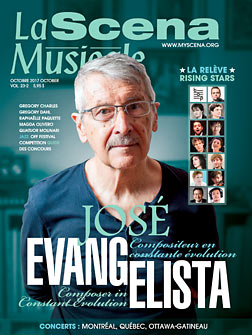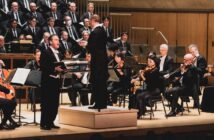
Orchestre de la Francophonie: End of Season Concert
- 4.5 Stars
- Simon Rivard, conductor. Mahler Symphony #4: Julie Triquet, violin, Andréanne Brisson Paquin, soprano.
- August 4, 2017. Chapelle Notre-Dame de Bon-Secours.
- Performance: 9/10
What you missed:
Having heard the 2017 Orchestre de la Francophonie early in its season, this reviewer can attest to the remarkable improvement that occurred under Rivard’s tutelage. Haydn’s Trumpet Concerto opened the programme. It was performed with impressive facility by Tyler Lindsay, an orchestra member. In this work, the violins in particular aptly rendered the deceptively difficult accompaniment. Next up was Milhaud’s surrealist ballet score Le Boeuf sur le toît. The orchestra used Jean-Marie Zeitouni’s arrangement and featured the ebullient violinist Julie Triquet. Here the players are to be complimented for their vibrant execution of intricate Brazilian tango rhythms.
Mahler’s Symphony #4 occupied the second half. Although this is the most accessible of Mahler’s orchestral works, it nonetheless constitutes a challenge for most professional ensembles, yet alone a youth orchestra. However, the Orchestre de la Francophonie played this symphony with aplomb. Kudos are due in particular to the principal horn and clarinet. In the final movement “Das himmliche Leben” (“The Heavenly Life”) was expressively sung by soprano Andréanne Brisson Paquin. – Ian Cochrane
Fantastic Bruckner
- 5 Stars
- Orchestre Métropolitain: Bruckner Symphony #5.
Yannick Nézet-Séguin, conductor. St. Joachim Church, Pointe-Claire, - September 8, 2017. Seat: right rear.
- Performance: 10/10
What you missed: A great way to start the musical season with Nézet-Séguin completing his Bruckner cycle for ATMA with Symphony #5. By this third performance, Nézet-Séguin had the work mastered, etching Bruckner’s long melodies into a colourful canvas. I had previously heard the Orchestre Métropolitain in Pointe-Claire a couple of years ago, but this time the sound from a back pew under the balcony was like cranking up the stereo.
Gripes: This was the third and last performance. Likely due to flight schedules, the piano concerto with Angela Chang was dropped. – Wah Keung Chan
Massed Mahler
- 4.5 Stars
- Montreal Symphony Orchestra: Mahler Symphony no. 8 in E-flat major, “Symphony of a Thousand”. Kent Nagano, conductor. Sarah Wegener, Camilla Tilling, Aline Kutan, sopranos; Allyson McHardy, Marie-Nicole Lemieux, mezzo-sopranos; Michael Schade, tenor; Russell Braun, baritone; David Steffens, bass. The OSM Chorus, Andrew Megill, chorus master; Petits Chanteurs du Mont-Royal, Andrew Gray, chorus master.
- Maison Symphonique de Montréal, September 21 (2nd performance), Seat: U17 parterre.
- Performance: 9/10; Soloists: 8/10.

Montreal Symphony Orchestra: Mahler. l to r: Marie-Nicole Lemieux, Allyson McHardy, Camilla Tilling, Sarah Wegener, Kent Nagano. Photo: Antoine Saito
What you missed: One of the best performances I have heard Nagano conduct. The sound of 350 musicians was tremendous. I would have given it a 10 if not for some imperfect voices. Top marks to soprano Sarah Wegener for her transcendent voice, reminiscent of the soaring voice Dominique Labelle. Aline Kutan in her small aria had us wanting more; mezzo Marie-Nicole Lemieux gave us a majestic voice; full marks also to baritone Russell Braun and the OSM Chorus. The sound from my seat in row U was better than most other locations.
Gripes: Tenor Michael Schade and mezzo Allyson McHardy. And why were there only two performances of this sold-out season opener? – Wah Keung Chan
Passionate Melodrama
- 4.25 Stars
- Opéra de Montréal: Puccini’s Tosca. Melody Moore-Wagner, soprano; Giancarlo Monsalve, tenor; Gregory Dahl, baritone; Valerian Ruminski, bass. Giuseppe Grazioli, conductor, Orchestre Métropolitain.
- Salle Wilfrid-Pelletier, September 16, 19, 21, 23.
- Team Ratings*: Staging: 8.8/10; Singing: 8.3/10; Conducting/Orchestra: 8.5/10
What you missed: American soprano Melody Moore-Wagner gave us an interpretation of Floria Tosca that captured Puccini’s passionate melodrama con brio, fragility, and resolve. The light and the dark in her voice seemed to pluck notes out of the air, then play with them like butterflies or bullets. Chilean tenor Giancarlo Monsalve, as Mario Cavaradossi, frequently struck gold, culminating in the iconic “E lucevan le stelle” (“And the stars shone”). This is sung in the third act, where the doomed artist and lover appears to know his fate, yet singing the heart-rending words “Never have I loved life so much.” As Baron Scarpia, Canadian Gregory Dahl imbued his role with shuddering authority. Dahl’s commanding voice and presence have earned him deserved prominence among the baritone voices of his generation.
With dexterously gauche and sometimes comic bass phrasing, American Valerian Ruminski sparked the maladroit, browbeaten soul of the Sacristan (church attendant) to life. Canadian baritone Patrick Mallette epitomized injured nobility as the fallen Consul Angelotti, giving the role its customary heroic vigour. And as Scarpia’s minion, Spoletta, Canadian tenor Rocco Rupolo expressed his dogsbody obediance to Beelzebub with just the right measure of Adolf Eichmann and the banality of evil.
Italian conductor Giuseppe Grazioli led Montreal’s Orchestre Métropolitain through Puccini’s pungent and highly emotional score with taste, judgement, and sensibility — and a sure sense of when to push taste into the gutter in order to achieve a desired aesthetic effect. The polished but unflashy stage direction of Andrew Nienaber, a rising star in the United States, helped, as did the splendidly apt and evocative sets and costumes devised by the brilliant Robert Perdziola. — Robert Kilborn
* La Scena Musicale team: Adrian Rodriguez, Natasha Pearson, Annie Prothin, Dino Spaziani, Mourad Benachour, Wah Keung Chan, Olivier Delaire, Patricia Weber, Robert Kilborn
Deux Chefs d’oeuvres
- 3.5 Stars
- Musica Camerata: Faure Quartet no. 1, op. 15, Brahms Quartet no. 2, op. 26.
- Chapelle du Bon-Pasteur, September 16, 2017.
- Performance: 7/10
What you missed: Each player had thoroughly prepared these masterworks of chamber music. At times the performers reacted with insightful sensitivity to the nuances of their collaborators. In the first movement of the Brahms, there were passages in which the balance and rhythmic coordination between the violin and the right-hand piano line were exquisite. The cello timbre was lusciously resonant in this acoustic.
Gripes: The tone of the piano was excessively bright, upsetting the overall sound and balance of the ensemble. The Chapelle’s piano would have been better at half-stick.
– Ian Cochrane















